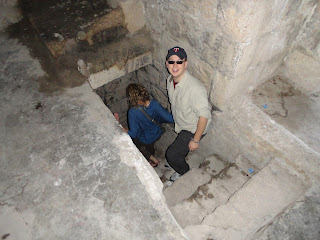Me on the Ramparts Walk (south route)
The title is from Psalms 122, the previous days weren't too busy just class and a group of us went to Mike's Bar on Thursday, which was fun, the bar is very American-like. I don't really like that.
Today was the Shabbat weekend so I enjoyed sleeping in and then walking around the Old City walls. We (a group and I) went from Jaffa Gate south then east on the ramparts walk. We saw the Armenian Quater the Dormition Abby on Mt. Zion and the Jewish Quarter. It was cool to think that defenders of this ancient city for thousands of years stood, guarded, and fallen where I walked. Our group then found this "secret passage", very Indiana Jones-like, and we climbed down it. We were surprised to find this quarter as a Hobo house we then continued down the ramparts bobbing our heading through the battlements to get some pictures and look at the area. We saw the Temple Mount and the Mount of Olives and the huge Jewish cemetery, I think its the largest one in the world. We continued off the wall, through the city to go back to Jaffa Gate to go the northern route of the ramparts walk.
Southern Route near Zion Gate
Going into the "secret passage"
Kids playing in razor wire
The Northern route went from Jaffa and ended just west of the Temple Mount in the Muslim Quarter. But, we are getting ahead of ourselves. Now we walked along seeing the Latin Patriarchate (Roman Catholic Housing) next to a family mosque and on the other side of the wall is the New City. We walked on going up stairs then down, up and down where we got to New Gate, which was built in the late 1800s and took pictures of the Christian/ Muslim Quarters. From there we went on to the Damascus gate, where the place was bustling on the streets with street merchants on the side of streets and in the middle of the streets. Here we were met by three Arab boys who were very brave, for they played in barb/razor wire stairways and they also asked us to take pictures of them with some of our ladies from our group. We saw nothing wrong with that, but we found out later that these boys were looking for something...mostly pickpocketing but also feeling the ladies behinds and being quite perverted, to say the lest. The ladies were fine and the boys didn't take anything, just scared the ladies abet and made us guys to be more aware. We then continued on after that ordeal and saw girls playing basketball, who then saw us and asked us guys our name. Apparently, Sam is a good name,but my name was not liked, maybe because Islam is from the Essau in the Abrahamic-side of the tree and the disliking of Jacob, I really don't know. We also saw boys playing soccer on really nice soccer fields with the background of the Temple Mount with the Dome of the Rock and the Mount of Olives. Wow, I dont think i would be paying attention to the game just thinking about the history of this place. We then came to the end and got off the wall int he Muslim Quarter we walked down the Via Dolorosa to get to our main street, Christian Quater st to find our favorite shopkeeper, Shabban. We walked back to campus and had enough time to look over some pictures from friends and get ready for dinner.
Tomorrow, Sunday, the Physical Settings class (all new students) will be going on a 11 hour walk around the Old City for class. This will be fun and I am ready to lear more about the City of Peace.















































